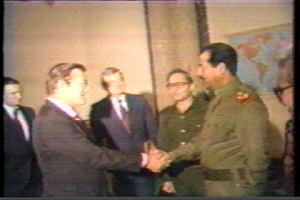Rice stands by claims of Al-Qaeda-Saddam links
51 minutes ago
WASHINGTON (AFP) - US Secretary of State Condoleezza Rice insisted that Al-Qaeda operatives in Iraq were developing weapons of mass destruction prior to the ousting of Saddam Hussein.
"There were ties between Iraq and Al-Qaeda," she said on Fox News Sunday.
Rice specifically linked Al-Qaeda's presumed leader in Iraq at the time, Abu Musab al-Zarqawi, to the effort to develop chemical arms.
"We know that Zarqawi was running a poison network in Iraq," she said, reaffirming statements made by President George W. Bush and herself prior to the March 2003 invasion of Iraq linking Baghdad with Osama bin Laden's group.
Rice stood by the claim Sunday despite a February 2002 report from the Defense Department's intelligence arm which was just released by a Senate Committee and stated that Iraq was "unlikely to have provided Bin Laden any useful (chemical or biological) knowledge or assistance."
more:
http://news.yahoo.com/s/afp/20060910/pl_afp/usattacksiraqqaedariceIraq used chemical weapons in 1983-1984, during the Iran-Iraq war. It has been reported that some 20,000 Iranians were killed by mustard gas, and the nerve agents tabun and sarin.
In 1988, Iraqi soldiers invaded Kurdistan and rounded up more than 100,000 Kurds and executed them. In March 1988, in the town of Halabja, more than 3,000 civilians died from chemical gas attacks by the Iraqi military.
Iraq has been rightly condemned by the U.S. and most of the international community for these and other deadly actions against its citizens and its neighbors. But Iraq did not operate against its enemies alone or without our knowledge, and in many instances, U.S. support.
Nightline, in Sept. 1991 reported that the Atlanta branch of an Italian bank, BNL, was able to funnel billions, some of it in U.S. credits, to Iraq's military. The U.S. apparently knew of the transfers and turned a blind eye.
"Sophisticated military technology was illegally transferred from a major U.S. company in Lancaster, Pennsylvania to South Africa and Chile and, from there, on to Iraq. The Iraqi-born designer of a chemical weapon plant in Libya set up shop in Florida, producing and then shipping to Iraq chemical weapon components. The CIA, the FBI and other federal agencies were made aware of the operation and did nothing to prevent it."
The report further states: "During the 1980s and into the '90s, senior officials of both the Reagan and Bush administrations encouraged the privatization of foreign policy, certainly toward Iran and Iraq. They made a mockery of the export control system; they found ways of encouraging foreign governments to do what our laws prohibited. They either knew or, if not, were guilty of the grossest incompetence, that U.S. companies were collaborating with foreign arms merchants in the illegal transfer of American technology that helped Saddam Hussein build his formidable arsenal."
It summarizes that, "Iraq, during much of the 1980's and into the '90s, was able acquire sophisticated U.S. technology, intelligence material, ingredients for chemical weapons, indeed, entire weapon-producing plants, with the knowledge, acquiescence and sometimes even the assistance of the U.S. government."
The New York Times reported in Aug. 2002 that during the Reagan administration, the U.S. military provided Saddam with critical intelligence that was used in Iraq's aggression against Iran, at a time when they were clearly using chemical and biological agents in their prosecution of that war.
The United States was an accomplice in the use of these materials at a time when President Reagan's top aides, including then- Secretary of State George P. Shultz, Defense Secretary Frank C. Carlucci and Gen. Colin L. Powell, then national security adviser, were publicly condemning Iraq for its use of poison gas, especially after Iraq attacked Kurds in Halabja.
The classified support reportedly involved more than 60 military advisors from the Defense Intelligence Agency who provided detailed information on Iranian deployments, tactical planning for battles, plans for air strikes and bomb-damage assessments for Iraq.
A retired intelligence officer recalled that, in the military's view, "The use of gas on the battlefield by the Iraqis was not a matter of deep strategic concern."
A 1994 Senate Banking Committee report (
http://www.gulfweb.org/bigdoc/report/riegle1.html), and a letter from the Centers for Disease Control in 1995 (
http://www.businessweek.com/print/bwdaily/dnflash/sep2002/nf20020920_3025.htm?db), revealed that the U.S. had shipped biological agents to Iraq at a time when Washington knew that Iraq was using chemical weapons to kill thousands of Iranian troops.
The reports showed that Iraq was allowed to purchase batches of anthrax, botulism, E. coli, West Nile fever, gas gangrene, dengue fever. The CDC was shipping germ cultures directly to the Iraqi weapons facility in al-Muthanna.
The National Security Archive at George Washington University has a collection of declassified government documents that detail U.S. support of Saddam's regime. This is the collection that contains a photograph of Saddam Hussein shaking hands with Ronald Reagan's Middle East envoy, Donald Rumsfeld, who apparently said nothing to Saddam about his nuclear weapons program or his use of chemical weapons. (
http://www.gwu.edu/~nsarchiv/special/iraq/index.htm)
